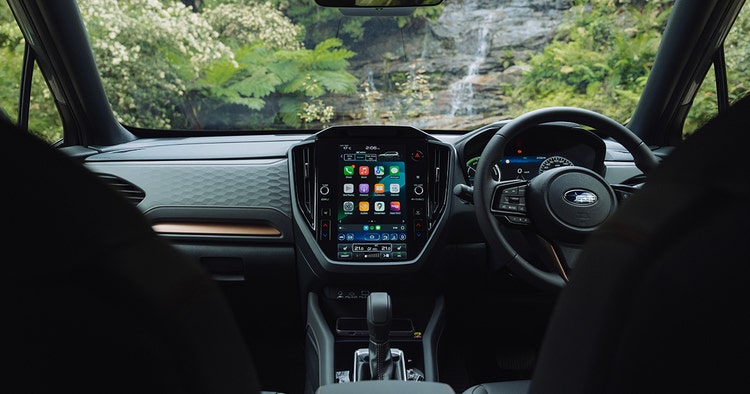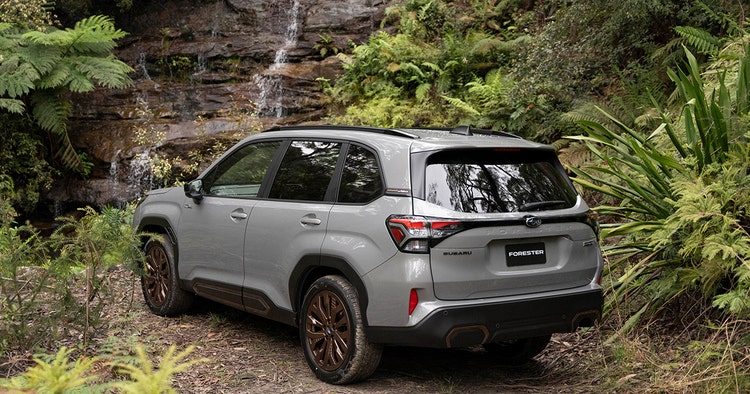Subaru Forester AWD Sport Hybrid 2025 Review
One of the original soft-roader pioneers, the Subaru Forester has evolved with the introduction of a new ‘Strong Hybrid’ powertrain.

By carsales.com.au
The Subaru Forester is one of the early pioneers of the compact SUV movement, first arriving in Australia in 1997.
And now the Japanese icon enters its sixth generation with an all-new model that retains the hallmarks of its predecessors while introducing a much-improved – and proper – hybrid powertrain, bolder styling and a significant improvement in driving dynamics.
Sadly, but also perhaps inevitably, it also comes with significant price rises.
How much does the Subaru Forester AWD Sport Hybrid cost?
Subaru offers a broad range of models across the new Forester line-up with seven unique variants split between four traditional petrol-powered versions and three new hybrids, which the Japanese car maker oddly calls ‘Super Hybrid’.

The entry point is $5000 higher than before, with the eponymous base-level petrol-powered Forester now costing from $43,490 (plus on-roads), making it one of the most expensive mainstream medium SUVs to access.
Sitting above that – and exclusively with a petrol engine – is the $46,490 (plus on-roads) Premium, with Sport (from $48,490 plus on-roads) and Touring ($50,990 plus on-roads) rounding out the range.
The Hybrid powertrain can only be had in three model grades – base, Sport and Touring – and commands a premium of between $3000 (base) and $6500 (Sport).
The larger offset in the Hybrid Sport version we’re testing here is due to the fitment of unique ‘enhanced’ shock absorbers and exclusive bronze 19-inch alloy wheels.
What standard equipment does the Subaru Forester AWD Sport Hybrid feature?
Helping to justify its price premium, even the entry-level 2025 Subaru Forester AWD Hybrid comes with a generous list of standard equipment that includes
- 18-inch alloy wheels
- LED headlights and taillights
- Keyless entry with push-button start
- Dual-zone climate control
- Cloth trim
- Heated driver and passenger seats
- One-touch electronic folding rear seats
- 11.6-inch infotainment touch screen
- Bluetooth connectivity
- Wireless smartphone mirroring
- Wireless phone charger
- DAB+ digital radio
- Six-speaker audio system
The Forester Sport AWD Hybrid adds:
- Bronze 19-inch alloy wheels
- Auto-folding side mirrors
- Power operated tailgate
- Sunroof
- 12.3-inch digital instrument cluster
- Water repellent seat trim
- Power adjustable driver and passenger seats
- 10-speaker Harmon Kardon audio
- Embedded satellite navigation
The Forester Touring AWD Hybrids adds:
- Gloss black 19-inch alloy wheels
- Synthetic leather and suede trim seats
- Ventilated front seats
What safety features does the Subaru Forester AWD Sport Hybrid have?
All variants of the Subaru Forester feature a comprehensive suite of advanced driver aids and crash avoidance systems under the banner of Subaru Eyesight.
It has already achieved a maximum five-star ANCAP safety rating according to the latest 2024 protocols.

Occupants are protected by nine airbags and there’s a long list of active features such as autonomous emergency braking, adaptive cruise control, lane keeping assistance, speed sign recognition, rear cross traffic alert, side view monitor, a 360-degree parking display with rear parking sensors.
A new innovation introduced to the Eyesight system uses the driver monitoring function and will automatically stop the vehicle in a safe manner (when adaptive cruise control is activated) if it detects the driver is unresponsive.
What is the Subaru Forester AWD Sport Hybrid like inside?
The new Forester’s cabin is very easy to see out of with high seating and big windows.
Rear seat and boot space is generous, and even the base model’s second row has a decent level of content: rear air vents, USB-A and USB-C ports, map pockets, small but useable door bins and a fold down armrest with dual cupholders.
The boot has bins, hooks and a small amount of underfloor storage. The cargo carrying capacity starts at 484 litres as a five-seater and expands to 1162 litres (1655 litres to ceiling) when collapsing the rear seat. This can be done electronically by levers in the boot.
Up-front, the new-design seats are large and supportive, but the real step forward is how much the infotainment experience has been cleaned up; the big screen in the centre stack has a logical menu structure that makes it relatively easy to understand.
Thankfully, physical buttons and permanent touch pads are retained for audio and air-con. The top part of the screen is partitioned to make it easier to access features like the X-Mode switch that adjusts the throttle mapping for off-roading.
The Forester also retains a logical family of physical buttons on the steering wheel. And cheaper models such as the AWD Hybrid still get the twin dial analogue instrument cluster, which many of us prefer anyway.
A grippier wireless charging pad surface would be appreciated since our smartphone had a tendency to slide off the pad and disconnect from charge when cornering, but at least it didn’t go flying off the pad and lodge on the far side of the passenger seat like in other SUVs…. Hello Haval Jolion.
What is under the bonnet of the Subaru Forester AWD Sport Hybrid?
All three Forester Hybrid variants share the same mechanical package that links its iconic 2.5-litre flat (boxer) four-cylinder petrol engine with electric motors supplied by its partner, Toyota, and a 1.1kWh battery pack

Using a Continuously Variable Automatic (CVT) automatic transmission with eight pre-programmed gear ratios to drive all four wheels, the Forester retains Subaru’s trademark symmetrical layout.
The petrol engine generates 121kW and 212Nm on its own, while the electric motor adds an additional 90kW and 276Nm for a maximum combined output of 145kW. Subaru does not provide a combined torque figure.
Whatever the result, it is a significant improvement over the previous mild hybrid set-up it replaces which used the smaller capacity 2.0-litre engine with 48V alternator to produce 110kW and 196Nm.
It is also – not surprisingly – better than the non-hybrid petrol, which now produces 136kW and 247Nm.
How fuel efficient is the Subaru Forester AWD Sport Hybrid?
Subaru claims the Forester AWD models consume an average of 6.2L/100km and are optimised to run on the most affordable 91RON standard unleaded.
With a 62-litre fuel tank, it can theoretically cover 1000km between refills.
What is the Subaru Forester AWD Sport Hybrid like to drive?
Unsurprisingly, the driving experience of the new 2025 Subaru Forester AWD Hybrid is at the top of the pops when it comes to what’s changed.
But it’s not the bit you might expect, instead it’s the dynamics – the steering and the handling are much sharper while the ride has lost some suppleness in the process without getting angry.
There’s no slack in the steering, the car sits obviously flatter and overall feels more playful and involving on both bitumen and gravel. It’s an interesting direction for Forester to take and more aligned to the dynamic reputation the first few generations enjoyed.
The dynamic improvements come from a number of sources, including a 10 per cent more torsionally rigid chassis, a new dual pinion electric assist steering system and revised suspension calibrations; the hybrids and petrols get different tunes in line with their different weights (a bit over 100kg model for model) and powertrain characteristics.
And what about off-road? And the new Forester Strong Hybrid’s mechanical all-wheel drive?

Our test car did clear some muddy and rocky trails and some moderate water crossings without a problem, but it was impossible to judge whether the system was better or worse than an electronically-activated set-up – obviously it’s something to assess when we start comparing the new Forester against its rivals.
In reality, this is not a vehicle capable of venturing into really challenging terrain, as per the rest of these all-wheel drive medium SUVs. But what the Forester AWD Hybrid (and petrol for that matter) has going for it off-road is a substantial 220mm ground clearance.
As for the hybrid powertrain, this new ‘Strong Hybrid’ is undoubtedly a substantial improvement over the old mild hybrid Forester in every possible measure, but it’s hard to see where that extra $3000-$6000 actually goes when driven against the essentially carry-over 2.5-litre boxer.
Flatten the throttle of either power unit from rest and the acceleration is pedestrian, something accentuated by the tendency of both CVTs to claim an rpm zone and sit the engine in it.
When you’ve already got some revs onboard and accelerate the response is undoubtedly better, although shifting from the default Intelligent to Sport mode didn’t change things drastically.
If you’re driving more on-and-off throttle in a typical city environment or a winding road, or on a steady throttle, the transmissions are pretty unobtrusive.
The eight ‘gear’ steps changed via steering wheel paddles (Subaru calls them sports regeneration paddles in the hybrid) are useful and enjoyable on a winding road, melding nicely with the car’s eager driving manners.
Based on our driving, the hybrid’s fuel economy also wasn’t significantly improved compared to the petrol: 7.6L/100km vs 8.6L/100km on the open road.
The e-motor’s low rev torque input and ability to run alone very slowly without burning petrol would have widened the hybrid’s performance and economy advantage over the petrol, but we did very little city running.
Off-road it actually displayed a concerning negative. Trying to inch up a slope by just cracking the throttle, the hybrid instead surged forward with much more intensity than intended, despite being in throttle-dulling and off-road-intended X-Mode. No harm no foul, but it wasn’t the expected response and suggests maybe there’s still some detail tuning required.
One more thing to note here. During the launch drive in New Zealand’s Canterbury district, a couple of cars did enter a safe mode. This was blamed on water entering the engine bay at a “sufficient level” during a creek crossing to “engage" a "protective fuse" safeguarding the radiator fan motor. Subaru says the cars did the right thing by temporarily shutting down and that the issue cleared after a fuse was replaced.
"At no point did the vehicle fail,” Subaru said in a statement. "In fact, it effectively demonstrated Subaru’s engineering capability and built-in safety systems, allowing occupants to reach their destination safely whilst still protecting key components of the vehicle."
How much does the Subaru Forester AWD Sport Hybrid cost to maintain?
All Forester variants are covered by a five-year/unlimited-kilometre warranty with roadside assistance.
Service is recommended every 12 months or 15,000km, whichever occurs first. And a five year/75,000km capped price servicing schedule averages out at $459.80 per visit.
Should I lease a Subaru Forester AWD Sport Hybrid?
The 2025 Subaru Forester AWD Sport Hybrid is a surprise because the part of the package we expected to make the biggest impression – the powertrain – didn’t.
Instead, it was the obvious improvements in dynamic behaviour that really grabbed our attention. Other things like the spacious interior were also really impressive.
The performance gains of the Strong Hybrid really only played a supporting role, so hopefully more diverse testing at home will reveal more of the story.
Add in the hefty price rises and we’re weighing pros and cons here rather than being prepared to offer and unequivocal thumbs up.
No doubt plenty of rusted-on fans will still sign up for the new Forester, but it’s hard to see it winning over heaps of new fans. There’s too much well-priced competition out there for it to do that.
2025 Subaru Forester AWD Sport Hybrid at a glance:
Editor’s Rating: 7.7/10
$54,990 (plus on-road costs)
Now
2.5-litre four-cylinder petrol-electric
121kW/212Nm (electric motor: 90kW/276Nm)
145kW
CVT automatic
1.1kWh lithium-ion
6.2L/100km (ADR Combined)
132g/km (ADR Combined)
Five-star (ANCAP 2024)
Disclaimer: Images supplied by Subaru Australia.